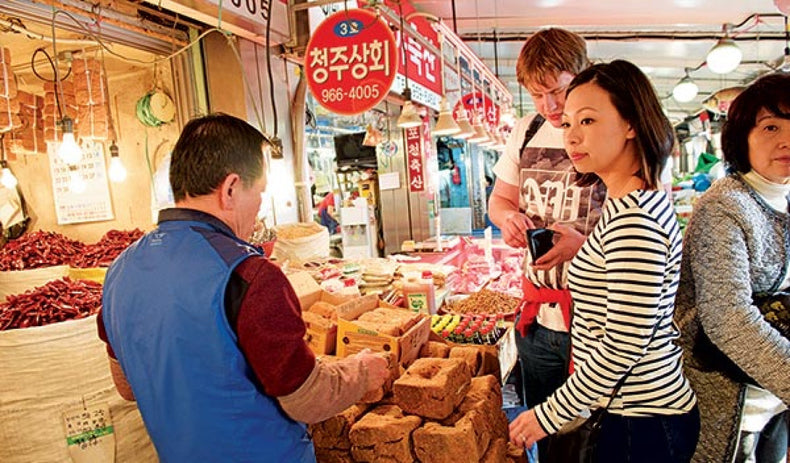The First Korean Street Food Cookbook

Da-Hae and Gareth West have just released cookbook K-Food: Korean Home Cooking and Street Food, a stunning and comprehensive guide to Korean cuisine. Da-Hae grew up in Busan, South Korea, and her husband Gareth couldn't believe how delicious Korean street food was when she cooked some for him (we're with him here!). Together they run American-Korean street food truck BusanBBQ.
What are your top tips for people trying their hand at cooking Korean food for the first time?
Da-Hae: The most important thing about Korean cooking is balance – both when it comes to flavours and with textures. Sweet and salty / sweet and spicy / fatty meat and crunchy tangy sides. If you keep these elements in mind, it can be pretty straight forward.
Gareth: Don’t be afraid about how powerful the flavours can be as Korean food is strong, earthy and punchy. Don’t forget there’s always kimchi to balance it all out.
Korean food is strong, earthy and punchy
What are your favourite Korean ingredients and why?
Da-Hae: Gochujang – my mum used to make gochujang when I was little as it was hard to get hold of in the UK at the time. I have really strong memories of licking it off my fingers and covering myself in it and it definitely kicked off my love of chilli from a young age. Gochujang is a fermented chilli bean paste which can be used to add a spicy, salty, sweet edge to any dish.
I have really strong memories of licking [gochujang] off my fingers... it definitely kicked off my love of chilli from a young age
Many people now know what kimchi is and the huge role it has in Korean food culture. What other flavours or dishes define Korean food for you?
Da-Hae: There’s a handful of Korean ingredients known as ‘jang,’ – which are made from fermented soy bean products: Ganjang (soy sauce), Gochujang (chilli bean paste), Doengjang (soy bean paste) – these three ingredients are essential for any Korean store cupboard and most Korean dishes will include at least one of these.
Gareth: Sesame oil – has a rich nutty flavour. It’s definitely worth shelling out for the more expensive pure roasted sesame oils as you need far less of it to get the full whack of flavour. This for me is one of the defining flavours of Korean food (and kimchi fried rice wouldn’t be the same without it).

What is your favourite Korean-fusion (or ‘Amerikorean’) dish?
Da-Hae: Buddae Jiggae – is one of most famous AmeriKorean mash ups. It’s a mix of the spam, hot dogs and processed cheese from American army ration packs (who were stationed in Korea during the Korean war) mixed with spicy Korean instant soup noodles to create a really filling, surprisingly hearty meal.
Gareth: Bulgogi burgers – were my first experience of Korean/American fusion. Instead of wildly changing the flavour of the burger - the sweet, salty flavour of the bulgogi sauce enhances the meatiness of the beef and adds to (instead of changes) this classic.
Sesame oil is one of the defining flavours of Korean food, and it's certainly worth shelling out for more expensive pure roasted sesame oil
The main inspiration for Busan BBQ was a bulgogi burger from a fast food restaurant in Korea. As Busan BBQ has evolved and Korean food has become more well-known in the West, what else has inspired you along the way?
Da-Hae: We’ve been back to Korea a few times since starting Busan BBQ and really enjoy trying out the different fusion restaurants that have popped up in Seoul such as Vatos Tacos (a great Korean/Mexican place in Itaewon). These guys are great at combining Korean flavours with familiar favourites to make Korean food much more accessible.
Gareth: London’s street food and chefs’ scene and its evolution has always been really inspiring. It’s exciting to have seen how these chefs and business owners such as Neil Rankin, Stevie Parle and Hanna from Kimchinary use Korean flavours and cooking techniques in their food to create great fusion combinations.
Da-Hae and Gareth West run The Busan BBQ,
Follow them on Twitter at @BusanBBQ



